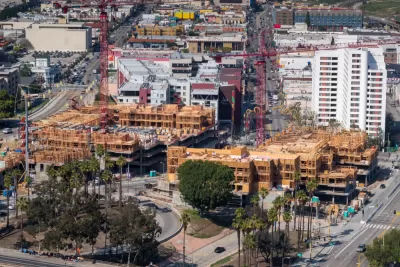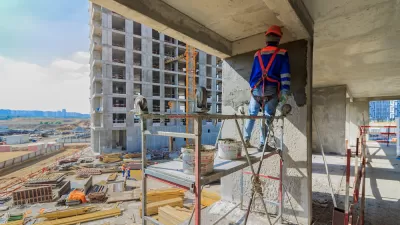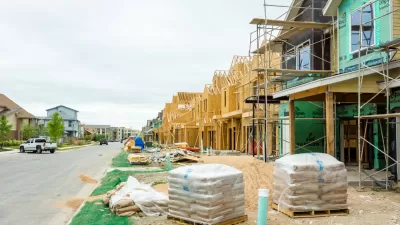An excerpt from the new book by Shane Phillips, "The Affordable City," published by Island Press.

The Three S’s: Supply, Stability, and Subsidy
How can more cities adopt reforms that are both pro-tenant and pro-housing, and how can we build upon that foundation to make our communities affordable, accessible, stable, and welcoming to all? How do we take slogans like “Housing Is a Human Right” and make them a reality, with concrete policies designed to create abundance and equity? How do we build coalitions with those who share our goal of affordable neighborhoods but who differ in their approach?
In The Affordable City, I argue that the solution to America’s housing crisis, both politically and technically, comes down to three coequal priorities that I call the Three S’s: Supply, Stability, and Subsidy.
 Supply is about having enough homes for everyone. When housing is hard to come by, all other obstacles to affordability and accessibility become exponentially more difficult to overcome. Rents and home prices rise as a result of scarcity, the cost of construction balloons as land and labor grow more expensive, landlords gain leverage over renters (and sellers over buyers), and poorer tenants are replaced by higher-earning households, with the less fortunate pushed to areas with fewer amenities and limited access to jobs, education, and community. Many cities have limited land available for development, but housing can always be built up rather than out. Oregon’s ban on single-family zoning is one example of how we can make more space on already developed land, though more aggressive tactics will also be required. Providing an abundant supply of homes is about growing the pie for everyone’s benefit rather than dividing it into smaller and smaller slices as a population grows. Supply is about recognizing the economic and physical realities of housing and making the most of both.
Supply is about having enough homes for everyone. When housing is hard to come by, all other obstacles to affordability and accessibility become exponentially more difficult to overcome. Rents and home prices rise as a result of scarcity, the cost of construction balloons as land and labor grow more expensive, landlords gain leverage over renters (and sellers over buyers), and poorer tenants are replaced by higher-earning households, with the less fortunate pushed to areas with fewer amenities and limited access to jobs, education, and community. Many cities have limited land available for development, but housing can always be built up rather than out. Oregon’s ban on single-family zoning is one example of how we can make more space on already developed land, though more aggressive tactics will also be required. Providing an abundant supply of homes is about growing the pie for everyone’s benefit rather than dividing it into smaller and smaller slices as a population grows. Supply is about recognizing the economic and physical realities of housing and making the most of both.
Stability is about recognizing the dignity of housing—that it’s more than an investment vehicle and a means of creating personal wealth, as it is often treated today. It relates to tenant protections and rental housing preservation, two overarching programs that ensure all residents have access to safe, clean, affordable housing without fear that the rug might someday be pulled out from under them.
Just-cause eviction protections and rent stabilization programs, found in Oregon, California, and elsewhere, are a few examples of stabilizing policy. Providing stability to those who want it, to renters in particular, is how we turn housing into homes. The people who most depend on this stability are neither wealthy nor politically connected, but their well-being is the barometer against which we measure our commitment to basic human rights and dignity. If supply is about the economic and physical realities of housing, stability is about our moral obligations to those who live in it.
Subsidy is about ensuring that everyone enjoys the benefits of abundant housing and stable communities. A well-regulated private housing market can serve a large portion of our population, and tenant protections paired with rental housing preservation can assist even more. But there will always be people who are left behind by these efforts—sometimes temporarily, sometimes permanently. Acting through the collective will of our local, state, and federal governments, we have a responsibility to provide support to those who need it and to live up to our professed belief that housing is a human right. This may take the form of rental assistance, publicly subsidized housing construction and acquisition, and a host of other programs. Local efforts, such as Los Angeles’s $1.2 billion measure to fund homeless housing and Durham, North Carolina’s $95 million housing bond, exemplify such programs, and proposals such as US Representative Ilhan Omar’s $1 trillion Homes for All Act would expand such programs to national scope. Supply and stability are our goals, and subsidy is an essential tool to ensure that they’re delivered to every member of society regardless of income or background.
Supply, Stability, and Subsidy are all indispensable ingredients in the affordable city recipe book, and each is discussed in much greater detail in the sections that follow. One without the others will not bring true affordability and stability to a community—certainly not to all who need and deserve it. Nor can we simply enact the strongest possible intervention for one goal without considering its impacts on the others. Often, the most aggressive solution to one problem will undermine the best response to another.
Without the support of tenant protections and public subsidies, unfettered development may keep prices from rising but also may raise concerns about displacement and community disruption. It may stabilize rents but by itself be unlikely to dramatically lower them. And it almost certainly won’t create housing that’s affordable to those subsisting on poverty-level or working-class wages. Supply may depend on the market, but advocates for supply should not be solely and slavishly devoted to the “free market.” Pro-supply housing policies are essential, but they’re not enough by themselves.
Without supply to stave off scarcity and public funds to support those with the greatest need, the benefits of tenant protections and rental housing preservation will be unnecessarily constrained. Policies such as rent control help existing residents stay in their homes, but they do little to accommodate future growth from native-born children, new residents from other cities and states, and immigrants. They may keep things from getting worse for many renters, but they have little power to make things better. Designed poorly, price controls may also replace income-based discrimination with other, more insidious forms of discrimination, such as those based on race, gender, family composition, or other perceived markers of “good” tenants. Tenant protections and rental housing preservation are essential, but they’re not enough by themselves.
Without an adequate supply of housing and robust tenant protections, additional public funding will mostly be captured by higher rents and construction costs. We’ll end up pouring huge sums of money into assistance for people who, if not for poor policy decisions relating to supply and tenant protections, would never have needed assistance in the first place. And we’ll have less money left over to assist the people who truly need it. Public subsidies are essential, but they’re not enough by themselves.
The Three S’s framework, despite drawing inspiration from groups at different ends of the housing advocacy spectrum, is not a moderate approach. Admittedly, it doesn’t call for unrestricted deregulation or a socialist revolution; in that sense, it doesn’t go as far as some would hope (or demand). By any other standard, though, the policies and strategies discussed in The Affordable City are bold, proven to be effective, and unquestionably controversial. They won’t remove all barriers to housing or make our public sector the primary supplier of housing. But they can absolutely set us on a better course.
A Vision for Affordable, Accessible Cities of the Future
The short- and medium-term goals of a Three-S policy framework are ambitious: more affordable housing for all, stability and protection for those who desire it, and abundant resources to assist the most vulnerable among us. The long-term goals of this comprehensive policy set are much grander, however. These grand ambitions are important not just for the positive impacts they’ll have on renters and on society more broadly but also because successful advocacy requires a vision that inspires collective action on a massive scale.
The vision embodied by these policies looks something like this. It’s a nation in which renters, not landlords, wield the most power in the market—and where public- and nonprofit-owned housing is so abundant that private property owners must keep their rents affordable in order to compete.
It’s a place where renting is safe, healthy, and stable, where tenants needn’t worry that they might someday lose their homes because of circumstances outside their control. It’s a place where existing residents get to enjoy and continue contributing to the fruits of a thriving community.
It’s a country where homeownership is available—and affordable—for those who desire it, but is not the only path to stability and is not the primary means of wealth creation. It’s a place where housing is inexpensive and we’re free to invest our money in new and growing ventures that improve society rather than aging structures that become less affordable year after year.
It’s a future of abundance, not scarcity, in which new neighbors, new jobs, and new homes are welcomed rather than feared. A future in which residents don’t need to worry that changing demographics or gentrification may cost them their livelihoods, their homes, or both.
It’s a national commitment to housing for all, in which we don’t limit the provision of shelter to those who “deserve it” or those who win a lottery, because everyone deserves a place to call home regardless of income or ability or background.
At its core, it’s a vision for America in which affordability and stability are guaranteed no matter where, or how, we choose to live. Renters and owners, wealthy and poor, families and groups and individuals—all should live without fear of losing their home, sleeping on the street or in their vehicle, or making the impossible choice to sacrifice food, utilities, or medicine in order to pay their rent.
This may sound utopian, and in a sense it is: politically, we are very far from realizing this vision. But it’s also a vision worth fighting for—and, with an approach to housing that prioritizes Supply, Stability, and Subsidy, it is achievable. In the more than 50 policies and strategies that follow, I explore how we might get there together.
Shane Phillips is an urban planner and policy expert based in Los Angeles. He is currently managing the UCLA Lewis Center Housing Initiative and teaching public policy as an adjunct instructor at the University of Southern California. Phillips previously worked as the Director of Public Policy for Central City Association, a Downtown LA advocacy organization. His new book is The Affordable City: Strategies for Putting Housing Within Reach (and Keeping it There) and writes about housing and transportation policy at Better Institutions.

Maui's Vacation Rental Debate Turns Ugly
Verbal attacks, misinformation campaigns and fistfights plague a high-stakes debate to convert thousands of vacation rentals into long-term housing.

Planetizen Federal Action Tracker
A weekly monitor of how Trump’s orders and actions are impacting planners and planning in America.

Chicago’s Ghost Rails
Just beneath the surface of the modern city lie the remnants of its expansive early 20th-century streetcar system.

Bend, Oregon Zoning Reforms Prioritize Small-Scale Housing
The city altered its zoning code to allow multi-family housing and eliminated parking mandates citywide.

Amtrak Cutting Jobs, Funding to High-Speed Rail
The agency plans to cut 10 percent of its workforce and has confirmed it will not fund new high-speed rail projects.

LA Denies Basic Services to Unhoused Residents
The city has repeatedly failed to respond to requests for trash pickup at encampment sites, and eliminated a program that provided mobile showers and toilets.
Urban Design for Planners 1: Software Tools
This six-course series explores essential urban design concepts using open source software and equips planners with the tools they need to participate fully in the urban design process.
Planning for Universal Design
Learn the tools for implementing Universal Design in planning regulations.
planning NEXT
Appalachian Highlands Housing Partners
Mpact (founded as Rail~Volution)
City of Camden Redevelopment Agency
City of Astoria
City of Portland
City of Laramie





























